Original Publication DATE: 8/10/2011
Conifers possess highly derived adaptations that allow them to flourish on continental land masses north and south of the 45th parallel—to the arctic tree line. They also grow in similar regions with decreasing latitude, like the various cordilleras of western North America. Though they comprise less than 1% of all plant species (~630), they define 30% of the forests on Earth. In order to survive in colder climates conifers must be able to handle temperature and moisture extremes. As a cat preens its fur, most conifers care for their needles. These waxy progeny are coddled when energy is diverted from other tree functions to maintain needles—often for many years. This heavy investment must allow needles to endure both high and low temperatures while at the same time regulating water loss during the warmer months. Also, because most conifers are evergreen, they are not inhibited by late spring or even summer frosts which might otherwise kill the leaves of a less cold-adapted species. Angiosperms–many of which are deciduous–generally inhabit lower elevations and warmer regions where they spend less time and energy in leaf production and maintenance and can therefore allocate resources to grow faster and pioneer oft-disturbed landscapes more rapidly. It it these two generalized survival regimes that had me confused on a recent backpack into the Pasayten Wilderness where there is a conifer that has blazed a unique path for survival on the edge of the Washington State alpine tundra.

Subalpine larch (Larix lyallii) has a range restricted to the North Cascades and Northern Rockies where they are locally common on exposed rocky areas as well as pioneers on disturbed sites and more recently in snowfields. They do not compete well with nearby conifer associates because they are shade intolerant. For this reason, over time they have been chased upward in an attempt to stay away from other cold loving conifers of the region like Engelmann spruce (Picea engelmannii) and subalpine fir (Abies lasiocarpa). Life on the edge of the alpine tundra includes a deciduous disposition, which appears to be the antithesis of the cold-loving-conifer survival strategy. It was mysterious to me that this tree would evolve deciduous leaves in subalpine conditions. Few other plants here are deciduous and those that are are about 3 inches tall. During our week-long trek we spent 4 days at high elevations–giving me ample time to ponder this unique species.
What follows are my interpretations–anthropocentric and otherwise–as to why this survival regime is effective.

1. Deciduous leaves

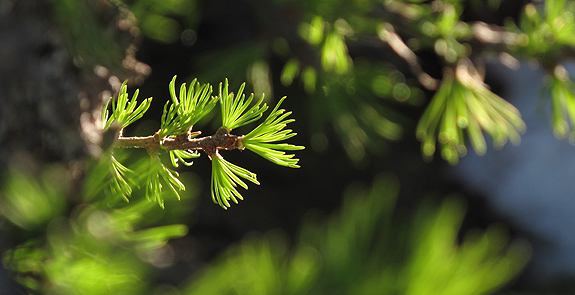

2. Time needle growth and pioneer disturbed sites
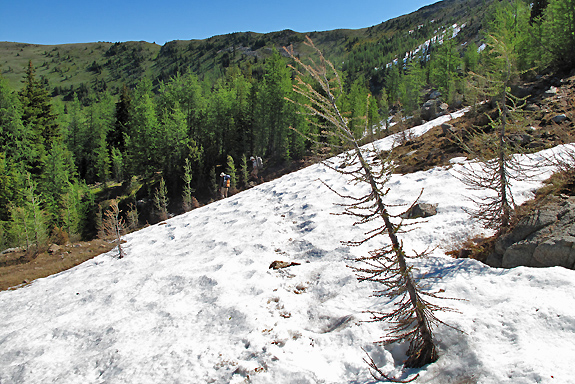


3. Winter snow will rarely weigh down and break branches
Because these conifers are deciduous they do not have to maintain the typical model conforming growth form other evergreen subalpine conifers do (see Massart’s Model below). This “Christmas tree” form is common at high elevations because it is effective in sloughing heavy snow and limiting branch breakage as snow accumulates on needles. Subalpine larch have no needles in winter so I can only assume snow will collect in limited amounts–generally not enough to break branches. This is also an effective strategy during the growing season for a shade intolerant species. As seen in Ruah’s model below, the larch is able to maintain a growth form more typical of a temperate oak or even a tropical species while in the subalpine–spreading and splaying branches to maximize net photosynthesis for this shade intolerant species.

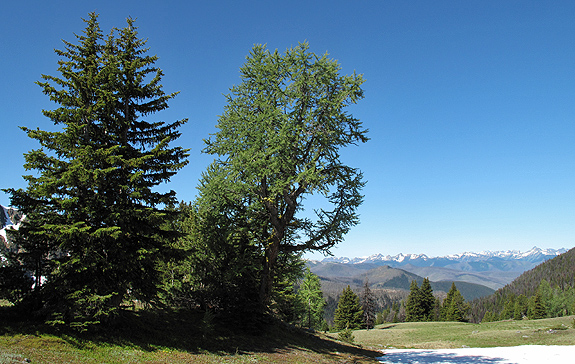
4. Reiterations in response to damage
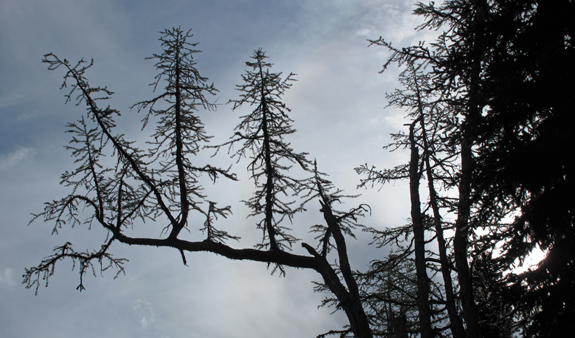
5. Epicormic sprouting
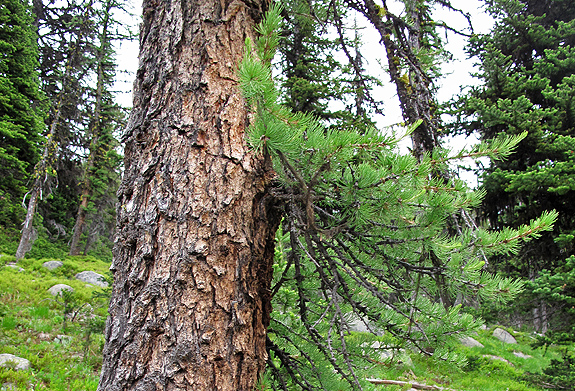
More thoughts on the deciduous disposition from Northwest Trees1
- Since leaves are not exposed to desiccating wind and cold in the winter, like evergreen conifers, the moisture in needles does not have to be replaced by water in the soil–which often remains frozen and inaccessible into late spring for many other conifers.
- Buds on the larch protect shoots in a tough woody layer and these are not vulnerable to winter damage like evergreen conifer needles.

References
1. Arno, Stephen., Hammerly, Ramona. 2010. Northwest Trees. Mountaineers Books, Seattle, Washington.
2. Tomlinson, P.B. 1983. Tree Architecture. American Scientist. 71:141-149
COMMENT:
AUTHOR: Ronald Lanner
URL: https://www.ronaldlanner.com
DATE: 8/10/2011 7:46:48 PM
Nice travelogue through alpine larch country, but full of unsubstantiated material. For example, where did the idea come up that waxy coating on needles confers hot-and-cold resistance? Maybe I have missed this, but it sounds to me like a conclusion based on logic rather than evidence. The idea that the larch has been “chased” upslope by those other conifers is unprovable and not serious. And aren’t lodgepole and whitebark pines also shade-intolerant? As for the needle length and number being “allocated” for optimum results — length is generally determined by length of the growing period in that year, and number of short shoot leaves is controlled by primordium formation in the previous year. Have you data saying otherwise?
North slope habitats are not chosen — seeds just landed there and established seedlings. I know you don’t mean that literally, but if the idea is to be scientific, then anthropomorphism should be eschewed.
Everything you say about the models of Halle’,Oldeman and Tomlinson in their 1979 book from which Tomlinson’s article is drawn, is dubious at best. They give zero evidence that any of their models are adaptive — plenty of speculation but zero evidence. For example, they cite a Cycad whose male and female plants are of different models. They use the same model for krummholz balsam fir and for the tropical rain forest kapok. They derived nearly all the models from trees growing not in the wild, where natural selection is at work, but in botanical gardens. Their drawings are very nice, and their terminology is kind of cute (“reiteration” has become especially popular among ecologists because it sounds profound), but their ideas (which avoid comparison with other peoples’ ideas) are really pretty half-baked and add no new understanding to tree structure. The open-grown larch you say can be branched that way because its deciduousness prevents it from accumulating snow looks much like evergreen whitebark and limber pines that also survive snow.
Larch epicormics do not come from the vascular cambium, they are from dormant buds embedded at the base of branches. And they emerge even without injury occurring, and have nothing to do with abundant water.
—–
COMMENT:
AUTHOR: Michael Kauffmann
DATE: 8/10/2011 8:28:45 PM
Ron- Thanks for the feedback. I do indeed impart an anthropomorphic view on the plant world hoping to blend a scientific understanding with often unsubstantiated–and unanswered–theories. A way of asking questions so as to slowly get to the answers over a lifetime of learning and observing. And hey, it is fun to think about these mechanisms and the dynamic ways which all factors interact. Surely there is not one answer…
What I think is interesting about those models is just that–there is not yet evidence they are adaptive, and may never be in our lifetime. But the structural similarities between trees in certain regions across the world is hard to argue with and must imply deep-time adaptations. You bring up a good point about the whitebark and limber pines, but their mechanism for achieving that growth form must be the flexibility and resilient nature of the wood itself. Might that same adaptive model have a ‘convergent’ reflection in the larch through the mechanism I propose?
Lastly, thanks for setting me straight on the epicormics, I’ll fix it in the blog. But, surely a tree will not sprout a new shoot if resources like water are limited, right? I have read your paper ‘Why do trees live so long’ about western larch and its response to damage through epicormic shoots. I have also read that shoots sprout, particularly in dense coastal redwood forests, when light availability increases, so might these shoots in the larch respond to resource availability (water) at high elevations?
Thanks again for the feedback. It is what I hope for! I am practicing my writing skills while reflecting on the natural world–a terrific way to learn but I won’t know I am wrong unless corrected. I would love to read more about this fabulous tree and its survival regime if you can recommend any reading or share more of your thoughts here–why do you think the deciduous disposition works?
—–
COMMENT:
AUTHOR: Ronald Lanner
URL: https://www.ronaldlanner.com
DATE: 8/10/2011 11:12:49 PM
I dunno. I look out my den window and see California black oak (deciduous), interior live oak (evergreen), valley oak (decid.), canyon live oak (evergreen), and blue oak (decid.). They all look happy in this common environment despite the longings of ecologists to theorize them into conformity.
—–
COMMENT:
AUTHOR: David Fix
DATE: 8/11/2011 5:33:44 AM
Michael, that is really well written. You have a skill for combining a scientific lesson (or 17) with aesthetics. Although it has been nearly thirty years since I’ve experienced this tree, I remember it well from timber stand exams in ex. nw. Montana. In the drainage in which I was camping and working, autumn colored a broad finger of western larch extending up-valley and eventually petering out with increasing altitude–while a narrow finger of that same yellow-gold came down the ridge above and also eventually petered out, but because it was too low. A couple thousand feet of spruce and fir interceded, in which there was essentially no larch. I did a watercolor once that shows many of the places, concepts, and things that I value, and subalpine larch is among few plants that made it into the painting. I’m looking at that painting over my shoulder as I write.
—–
COMMENT:
AUTHOR: Joyce Grunewald
DATE: 8/11/2011 12:35:49 PM
Loved the picture of the larch with the Alpine Tundra in the background! Great shot of the three Thomas Hall boys. I especially like any picture where I can see your fingertips…love, Mom
—–
COMMENT:
AUTHOR: Michael Kauffmann
DATE: 8/11/2011 1:00:14 PM
Watercolor? You cease to amaze me David! I’d love to see some of your art work some day – Allison too is a watercolor student and quickly becoming quite proficient. Lauren Lester is featured at the Natural History Museum over the next two months, her work is amazing.
Thanks for the kind words–it was an amazing tree to get to know. I hope that I can spend time with it again soon.
—–
COMMENT:
AUTHOR: Michael Kauffmann
DATE: 8/11/2011 1:22:14 PM
Ron- Clearly I am no expert in growth models. All I was simply hypothesizing is that, since plants undeniably grow toward light, larch enjoyed a unique freedom–uninhibited by winter leaves–that sculpt an uncommon high elevation form and hence function (I just added a new photo with captions that I hope illustrates that message better). It is undeniable that this is one of the most unique high elevation conifers in terms of its survival regime, and this blog post was meant to celebrate that as well as be a vector for my mental derivations and celebrations. I beg you to continue to keep me on my toes and share your knowledge with my readers and I.
—–
COMMENT:
AUTHOR: Kevin Geraghty
DATE: 4/19/2012 5:40:58 AM
I agree that the “deciduous conifer” thing breaks the model, and causes puzzlement, but this is not limited to l lyalli; all larches do it; most species are associated with cold or other forms of “bad” sites.Western larch (l. occidentalis) being an obvious exception.
A common pattern in the Pasayten is whitebark pine forms the south-facing tree-lines, and lyall’s larch north-facing. Not clear why. One theory I have heard Clark’s nutcrackers propagate the whitebark and they cache seeds in areas of thin snow cover (e.g. s-facing slopes).
Also, you didn’t mention it, but in the Cascades context lyall’s larch is associated with distinctly east-side rain-shadowy tree lines. Farther west it is subalpine fir, and west of that, mountain hemlock. (simplifying, of course). This suggests an issue with snow depth, or a comparative advantage in cold treelines with little protection afforded by snowpack.
Kevin- Thanks for the comments – you are right, there is no easy way to generalize these trees but they sure are fun to think about. High elevation pines in general prefer south-facing slopes because they are shade-intolerant and these sites generally offer less competition. Nutcrackers clearly play a roll too. -MK

I’m fascinated by conifer biogeography and am a fan of your books and blog. I do however have a question about #4 above, regarding reiteration in response to damage. I had to re-read it a few times, and don’t quite follow your logic. Boiled down you seem to be saying that reiteration is an effective strategy for Larix trees damaged by snow because they aren’t subject to damage by snow due to their deciduous needles.
Donald, thanks for reading the blog and for using my books! You are right, it is not clear the way I state it. But what I mean is that subalpine larch can pursue this unusual growth form in snowy environments because the species does not have needles in the winter on which snow might accumulate and break branches under the weight. How the branch might break in the first place so that reiterations occur is a different matter altogether. I hope that helps clarify!